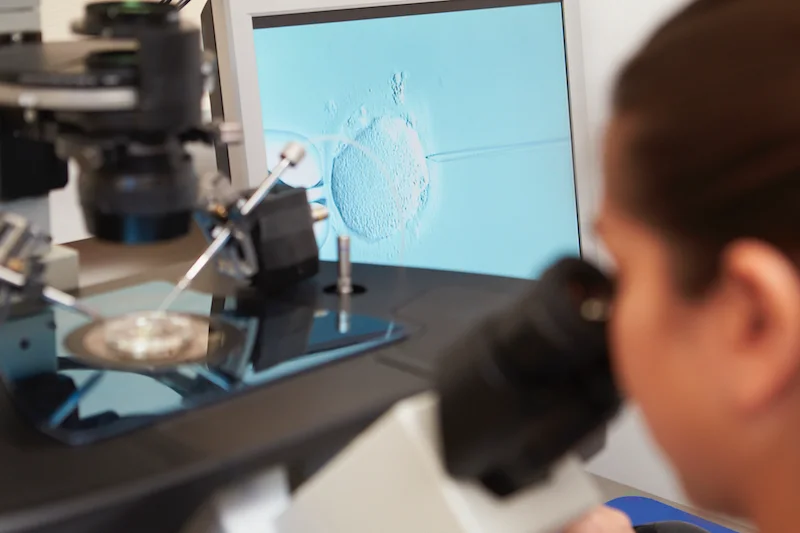The Science Behind Embryo Monitoring and Time Lapse Imaging: A Closer Look at the Technology Changing IVF
In vitro fertilization (IVF) has transformed the field of reproductive medicine, offering hope to couples struggling with infertility. In vitro fertilization (IVF) is a process that takes place in a laboratory where eggs are fertilized with sperm. After fertilization, the resulting embryos are carefully placed into the woman's uterus for implantation. One of the critical factors in the success of IVF is the selection of the healthiest embryos for transfer. This is where embryo monitoring and time-lapse imaging play a crucial role.
Embryo monitoring involves continuously observing and assessing embryos during their development in the laboratory. On the other hand, time-lapse imaging is a technology that captures images of embryo development at regular intervals, allowing embryologists to analyze the growth and behavior of embryos in real-time. These advancements in technology have significantly improved the success rates of IVF by providing valuable insights into embryo development and aiding in the selection of the most viable embryos for transfer.
The Role of Embryo Monitoring in Improving IVF Success Rates
Embryo monitoring has revolutionized the field of IVF by providing embryologists with a wealth of information about embryo development. By continuously observing and assessing embryos, embryologists can identify the healthiest embryos with the highest chances of implantation and pregnancy. Identifying the healthiest embryos is particularly important because not all of them have the same potential for success.
Through embryo monitoring, embryologists can assess parameters such as embryo morphology, cell division rate, and quality. Through the analysis of these parameters, they are able to identify the embryos that are most likely to lead to a successful pregnancy.
Statistics have shown that embryo monitoring has significantly improved IVF success rates. A study published in the journal Fertility and Sterility discovered that using embryo monitoring techniques resulted in a 20% increase in live birth rates compared to traditional methods. Another study in the same journal reported a 30% increase in live birth rates when time-lapse imaging was used for embryo selection. These findings highlight the importance of embryo monitoring in improving IVF success rates.
Understanding Time Lapse Imaging: How it Works and its Benefits
Time-lapse imaging is a groundbreaking technology that allows embryologists to capture embryo development images regularly. This imaging provides a detailed and comprehensive view of the entire process, allowing for a more accurate assessment of embryo quality and viability.
The process involves placing embryos in a specialized incubator equipped with a camera that captures images at regular intervals, typically every 5-10 minutes. These images are then combined into a time-lapse video, allowing embryologists to observe the development of embryos in real-time.
One of the critical benefits of time-lapse imaging is that it eliminates the need for manual observation of embryos under a microscope, reducing the risk of disturbing the embryos and providing a more accurate assessment of their development. Additionally, time-lapse imaging allows embryologists to detect subtle changes in embryo development that may not be visible with traditional methods. Gaining a broader view can help embryologists identify embryos with the highest chances of success, leading to improved IVF outcomes.

The Importance of Embryo Selection in IVF: How Time Lapse Imaging Helps
Embryo selection is one of the most critical steps in the IVF process, as it determines which embryos will be transferred into the woman's uterus. Traditionally, embryo selection was based on a visual assessment of embryo morphology, which involves evaluating embryos' shape, size, and quality under a microscope. However, this method has limitations as it relies on subjective judgment and may not accurately predict embryo viability.
Time-lapse imaging has revolutionized embryo selection by providing embryologists with a more objective and accurate assessment of embryo development. By analyzing the time-lapse videos, embryologists can identify specific developmental milestones and assess the timing and quality of cell divisions. This assessment allows them to select embryos more likely to result in a successful pregnancy.
Compared to traditional methods, time-lapse imaging offers several advantages in embryo selection:
- It provides a more comprehensive view of embryo development, allowing embryologists to detect subtle abnormalities or irregularities that may not be visible with traditional methods.
- It allows for a more objective assessment of embryo quality, reducing the risk of human error and improving the accuracy of embryo selection.
- Time-lapse imaging provides valuable data that can be used to develop predictive models and algorithms for embryo selection, further improving IVF success rates.
The Science Behind Embryo Development: How Embryo Monitoring Helps in Understanding
Embryo development is a complex and dynamic process that involves a series of carefully orchestrated events. Understanding the stages of embryo development is crucial for improving IVF success rates, as it allows embryologists to identify the healthiest embryos and optimize the conditions for their growth.
Embryo monitoring plays a crucial role in understanding the science behind embryo development. By continuously observing and assessing embryos, embryologists can gain insights into the timing and quality of cell divisions and the formation of essential structures such as the blastocyst. This information helps them identify embryos with the highest chances of implantation and pregnancy.
Embryo monitoring also allows embryologists to study the impact of various factors on embryo development, such as culture media, incubation conditions, and genetic abnormalities. By manipulating these factors and observing their effects on embryo development, researchers can optimize the conditions for embryo growth and improve IVF success rates.
The Role of Artificial Intelligence in Embryo Monitoring and Time Lapse Imaging
Artificial intelligence (AI) has become a formidable asset in the field of reproductive medicine, specifically in the areas of embryo monitoring and time-lapse imaging. With the ability to analyze vast quantities of data, AI algorithms can detect patterns and correlations that may elude human observation. AI has the potential to revolutionize embryo selection and improve IVF success rates.
AI is used in embryo monitoring and time-lapse imaging to develop predictive models and algorithms for embryo selection. By analyzing the time-lapse videos and other data, AI algorithms can identify specific developmental milestones and assess the timing and quality of cell divisions. This algorithm allows for a more objective and accurate embryo quality assessment, improving IVF outcomes.
The benefits of AI in embryo monitoring and time-lapse imaging are numerous:
- AI algorithms can analyze large datasets much quicker and efficient than humans, allowing for more accurate embryo selection.
- Artificial intelligence has the ability to detect intricate patterns and correlations that may not be discernible to the human eye, thereby offering invaluable insights into the development of embryos.
- AI has the capability to grow and improve over time, leading to continuous advancements in embryo selection and IVF success rates.
The Future of IVF: Advancements in Embryo Monitoring and Time Lapse Imaging Technology
Embryo monitoring and time-lapse imaging constantly evolve, with new technological advancements rising. These advancements could improve IVF success rates further and revolutionize the field of reproductive medicine.
One of the key technological advancements is the development of more sophisticated time-lapse imaging systems. These systems can capture higher-resolution images at shorter intervals, providing even more detailed information about embryo development. Image analysis algorithms and AI technology advancements are also expected to enhance embryo selection accuracy and efficiency.
Another area of advancement is the integration of genetic testing into embryo monitoring and time-lapse imaging. Preimplantation genetic testing allows embryologists to screen embryos for congenital abnormalities before transfer, reducing the risk of genetic disorders and improving IVF success rates. The integration of genetic testing with time-lapse imaging has the potential to provide a more comprehensive assessment of embryo quality and viability.
The Impact of Embryo Monitoring and Time Lapse Imaging on IVF Costs
While embryo monitoring and time-lapse imaging significantly improve IVF success rates, there are also cost considerations. The initial investment in the technology and equipment required for embryo monitoring and time-lapse imaging can be substantial. However, it is essential to consider the potential cost savings in the long run.
Improving IVF success rates, embryo monitoring, and time-lapse imaging can reduce the cycles required to achieve a successful pregnancy. This reduction can significantly reduce the overall cost of IVF treatment, as fewer cycles mean fewer medications, procedures, and laboratory costs. Additionally, selecting the healthiest embryos for transfer, embryo monitoring, and time-lapse imaging can reduce the risk of multiple pregnancies, which can be result in higher medical costs.
It is also worth noting that as the technology for embryo monitoring and time-lapse imaging becomes more widely available, the associated costs are expected to decrease over time. As with any new technology, the initial costs are often higher but tend to fall as the technology becomes more established.
- Protecting Your Health: Choosing A Sperm Bank Over Natural Insemination
- Hatching a Plan: Learning The Basics About Assisted Hatching in IVF
- Navigating GYN Surgery Before Artificial Insemination
- PGT Testing and Its Role in IVF Treatment
- The Ultimate Guide To Where You Can Donate Sperm In All 50 States

